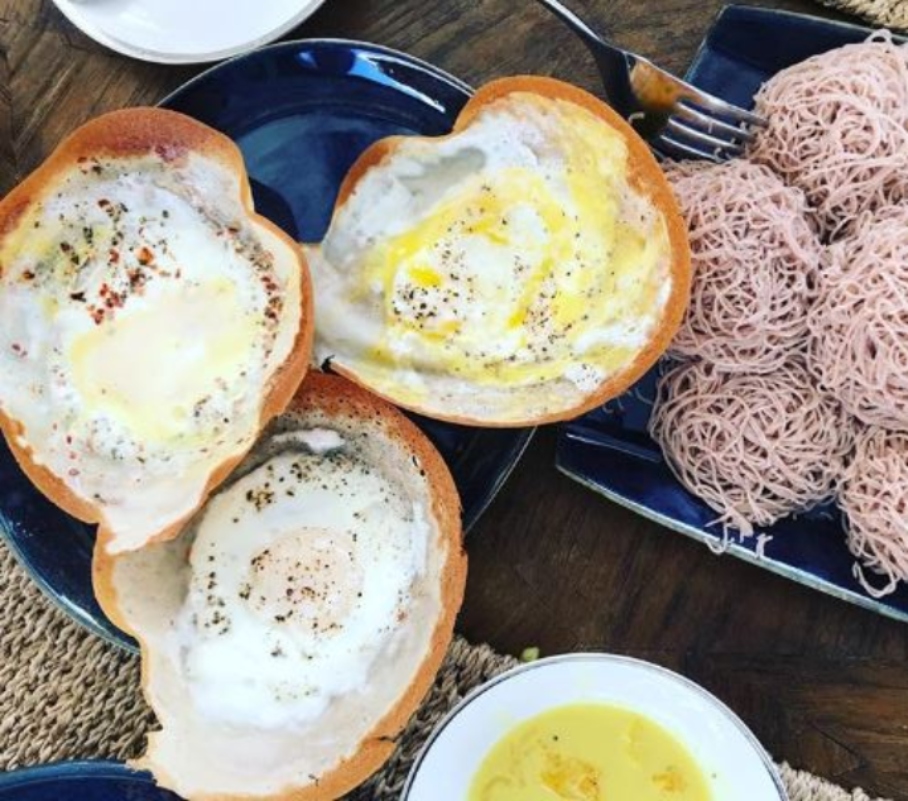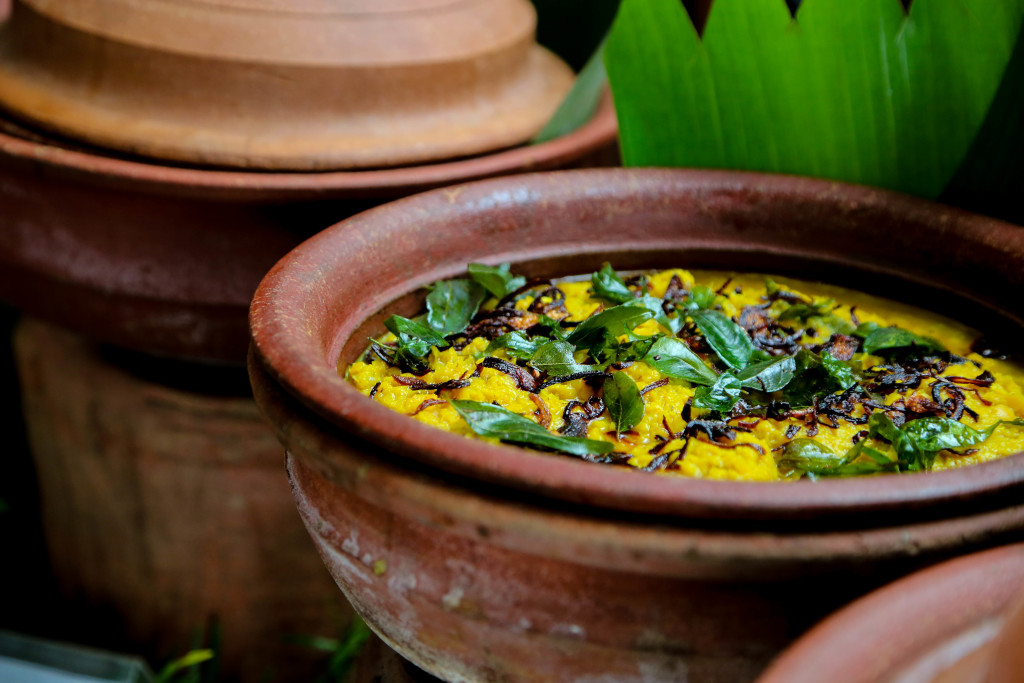When you’re in Sri Lanka, discovering local cuisine is of the essence. With a wide range of fresh, local produce, herbs and spices, Sri Lankan food is as delicious as it known for being tantalisingly spicy. From breakfast to lunch, tea time and dinner, every Sri Lankan dish is guaranteed to be an escapade for your taste buds. Here are 11 recommendations for dishes worth travelling to the island for:
1. Kottu roti
Kottu roti is often described as the local counterpart of the West’s iconic hamburger. A favourite amongst the Sri Lankan majority and visitors to the island alike, kottu roti is fast food ideally suited to those desiring something tasty and greasy. Prepared using a certain type of roti called “godamba”, it is deep-fried, cut and chopped with an assortment of vegetables, spices and meat chunks. The result? A mouthwatering preparation of dough chunks, meat and crispy vegetables. Preparation of kottu begins as dusk falls, in most parts of Sri Lanka. You will find it at many a street food vendor and Sri Lankan restaurant. For a more refined take on this Sri Lankan classic, the Nuga Gama at Cinnamon Grand Colombo is highly recommended for its authentic yet inspired rendition of local staples.

2. Hoppers
Hoppers are another local staple. They are essentially the South Asian equivalent of the West’s sourdough pancake. Hoppers tend to be sold alongside kottu, at street vendors across the country. The batter that is prepared from scratch comprises of a lightly fermented mix of rice flour, coconut milk and eggs. The mixture is ladled into a small wok and swirled around to evenly coat the pan with the mixture. Regardless of whether you prefer sweet or spicy food, hoppers are customisable. Sweet hoppers are known as “pani appa” and involve jaggery being included in the batter. Savoury hoppers on the other hand come with a fried egg in the center. The dish is usually paired with local condiments such as polos curry, dhal curry, coconut sambal or lunu miris.

3. Lamprais
Lamprais is traditionally a Dutch Burgher dish. It includes a boiled egg, aubergines, “frikkadels” (Dutch-style meat balls), cardamom, cloves and a sambal infused with cinnamon. Each aspect of the lamprais is prepared separately and collectively wrapped in a banana leaf. It is then baked on low heat for a few hours. The end result is an aromatic rice dish with a selection of curries and condiments that beautifully contrast with and complement one another. Sri Lankan cuisine doesn’t get any better than this!
4. Fish ambul thiyal
Sri Lanka has some of the busiest fish markets found in South Asia. Seafood is a prominent feature in Sri Lankan cuisine. While there is a range of fish to choose from, fish ambul thiyal, is made using tuna that is cut into cubes and then sautéed in a bevvy of spices. The spices used in this dish range from black pepper to garlic, onions, turmeric and most importantly, dried goraka. Goraka is a unique local fruit that lends ambul thiyal its signature tangy and subtly spicy flavour. Given this is a dry curry dish, very little water is used in preparing the dish. It can be eaten with rice, , pittu, hoppers or string hoppers and is a favourite amongst travellers staying at many a luxury hotel around the island that has seafood restaurants such as the Lagoon at Cinnamon Grand Colombo.
5. Gotu kola sambol
Gotu kola sambol happens to be one of the most widely consumed leafy green vegetable dishes in the island. It is prepared using Asiatic pennywort. This leaf is a medicinal herb used in ayurveda for the treatment of myriad ailments. The pennywort leaves are shredded and combined with onions, tomatoes, desiccated coconut and chilli. After this, it is seasoned with salt, pepper and a squeeze of lime. The sambol has a strong, herbaceous flavour, reminiscent of kale. It is a side dish that is fresh, tangy and the perfect accompaniment to the staple rice and curry.
6. Wood apple
Wood apple is a Sri Lankan fruit and South Asian delicacy whose size is on par with that of a de-husked coconut. The fruit has a very hard outer shell and a pungent aroma similar to blue cheese. It can be found at any fruit and vegetable market in the country. The shell is cracked open, usually by dashing it on solid ground. Once the shell shatters, a viscous, dark brown paste that is similar in taste and texture to tamarind paste and fermented prunes will be found inside. Wood apple is high in vitamin C and rich in B vitamins which make it a healthy and delicious addition to any smoothie. The fruit is a definite must-try, when in Sri Lanka.
7. Sri Lankan love cake
Sri Lankan love cake is a delicacy enjoyed throughout the year but none more so than during Christmas where it assumes its rightful position alongside Christmas Cake, breudher and other Christmas staples. The cake includes pumpkin preserve or “puhul dosi” that is similar to Portugese squash preserve called “doce de chila”. It is sweet, chewy, rich and aromatic thanks to the spices, rose water and cashews that go into its batter. Love cake is sold at most bakeries and found on the dessert menus of many restaurants in Colombo.
8. Fried salted fish
Fried and salted “salaya” fish are a delectable addition to Sri Lankan dishes. Unlike regular curries, the fish here are intensely salted and then deep fried so they retain their crunch. Their taste and texture pairs well with rice and curry. Maldive fish too are a popular condiment and are included in many different sambols and sauces. They are often included in katta sambol and lunu miris which are spicy chili sauces that pair well with most savoury Sri Lankan dishes.
9. Wambatu Moju
Wambatu moju is a flavourful, caramelised eggplant pickle. Eggplant is sliced and deep fried, giving it a light, crispy texture with a tender, seemingly silky interior. The caramelisation takes place with a mix of sugar, vinegar, onions, green chilies, mustard seeds, chili powder and turmeric powder until the vegetable darkens. On taking a bite, the eggplant should be tender to the point where it melts in your mouth. The flavour will be a contrast between sweet, sour and salty.
9. Kiri bath
Kiribath is a unique type of rice dish, prepared with thick coconut milk. It is often served during auspicious occasions, such as Sinhala and Tamil New Year. It can be eaten alongside a variety of different Sri Lankan dishes, and consumed either sweet, with jaggery, or consumed salty with sambols or curries. Kiribath is commonly garnished with lunu miris which is a sambol cum chili sauce. It comprises of chillies, onions, lime juice, salt and dry Maldive fish, that are ground into a paste using a stone mortar and pestle.
10. Pol Sambol
Sri Lanka is a country where the coconut is of supreme importance,There is no other Sri Lankan side dish that pays fitting tribute more so than pol sambol, does. It is a simple blend of grated coconut, onions, whole chillies or chilli powder, lime juice, salt and sometimes, maldive fish. The ingredients are ground up and then mixed together in a bowl. It can be used as a garnish or side dish accompanying any Sri Lankan dish. It pairs well with rice and curry, roti, naan, parata, hoppers and string hoppers, or even alongside slices of bread. If you love coconut, there’s no better garnish in the world.

11. Dhal curry
Dhal curry, is a popular curry and a staple in Sri Lankan cuisine. You will find it at any and every restaurant or household. The lentils have to be rinsed first and then boiled until tender.
In a separate pot, fresh ingredients like onions, tomatoes, mustard seeds and green chilies, are lightly fried and then combined with tempered cumin seeds, turmeric, fenugreek, and curry leaves. All the ingredients are combined and the mix is then thickened with a few tablespoons of fresh coconut milk to give the curry its distinct rich flavour and texture.

Sri Lankan cuisine reflects both its diverse landscape and resourceful citizens. The country has a tropical environment that comprises of coconut-fringed wet regions, arid dry regions and cooler highlands. This means that fresh fruit and vegetables, fish, meat and spices are found in abundance and variety here. In spite of the many foreigners who visit the country, surprisingly very few manage to sample local cuisine. To really experience the best of local food, make it a point to mix with the locals in the country. In doing so, you are likely to uncover the many culinary delights on offer here.
